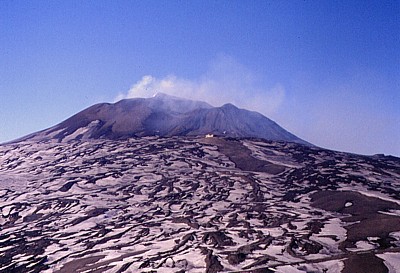| Etna
index |
||
| Geology | Geological history | Cones and craters |
| Eruptive characteristics | Eruptions before 1971 | Eruptions since 1971 |
| Etna and Man | References | Web sites |
| Weather forecasts | FAQ | Latest news |
| View
from the Montagnola toward the summit craters of Etna on 12 February
1998. The Southeast Crater, which has changed beyond recognition
since then, lies to the right of the then much larger central summit
cone, and a small intracrater cone looms over its rim. This cone,
which began to form about one year earlier, was the site of a fairly
regular Strombolian activity, and lava issued from vents at its
base, overflowing the crater rim in many places. The building in
front of the Southeast Crater is the Torre del Filosofo mountain
hut, an amazingly ugly structure (in terms of architecture), which,
however, has provided shelter and served for hosting scientific
monitoring instruments. In spite of its exposed location and its
proximity to the eruptive sites of 2001 and 2002-2003, it is still
there... though completely buried by the pyroclastic products of
the latest eruption |
Etna
photo gallery: 1998
Etna gains force (1)
![]()
In
1998, the activity of Etna began to become more varied than in 1997,
and, most of all, it significantly gained in intensity. Following
a somewhat erratic period in January-February (accompanied in mid-January
by an intense seismic swarm probably caused by magma intrusion below
the western flank), and an isolated paroxysm at the Northeast Crater
in late March, the activity picked up in the spring and early summer,
with spectacular lava fountains and explosions in the Voragine and
the Bocca Nuova. This culminated, on 22 July, with a powerful paroxysm
at the Voragine, which produced an enormous, mushroom-shaped eruption
column 10 km high and heavy tephra falls around the volcano. Shortly
thereafter, the Southeast Crater, which for nearly two years had
been the site of a marvellously faithful persistent Strombolian-effusive
activity, fell in complete silence. In mid-September, when the activity
at the neighboring Voragine and Bocca Nuova began to wane, the Southeast
Crater reawoke violently, and for a few days it seemed as though
it had resumed the regular persistent activity of the previous period.
However, it soon became clear that this was not the case. Instead,
the activity now consisted of brief, violent, and exceptionally
spectacular episodes of lava fountaining and lava flow emission.
These paroxysms at the Southeast Crater continued into 1999, heralding
an even more exciting period of summit activity... |
|
The photographs taken of Etna in 1998 are so numerous that they are presented on separate pages: Grand tour to the summit craters, 8 January 1998 Two visits to the summit craters, 10-11 February 1998 The discovery continues, 12-24 February 1998 A single summit visit in two months, March-April 1998 The Southeast Crater close-up, May 1998 Three summit craters active, June 1998 Exploding lava bubbles, a paroxysm, and aftermath, July-August 1998 The Southeast Crater returns on the stage, September-December 1998 |
Copyright © Boris Behncke, "Italy's Volcanoes: The Cradle of Volcanology"
Page set up on 30 July 2003, last modified on 7 February 2004

